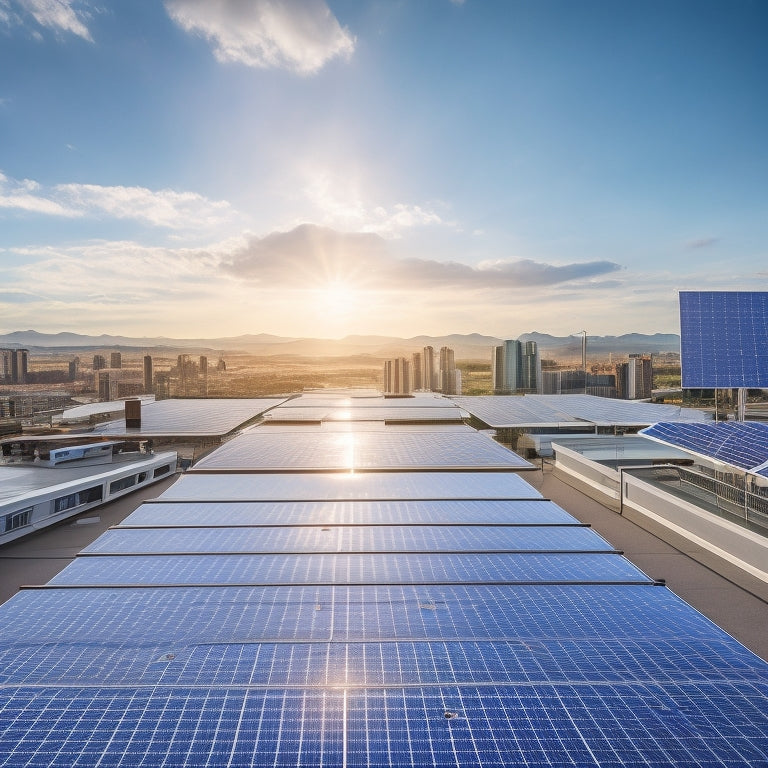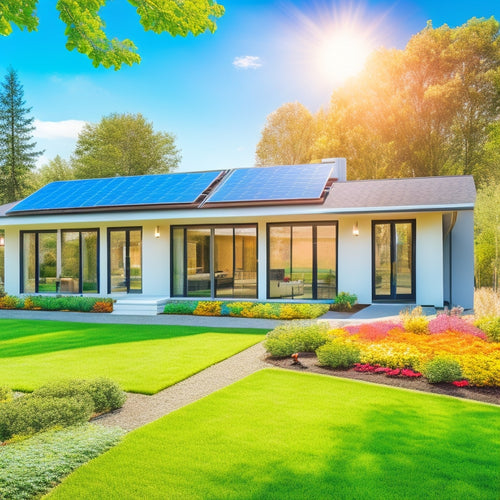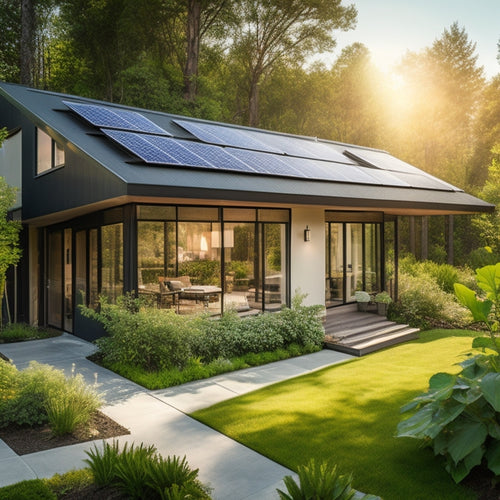
Do Solar Panels Make Sense for Commercial Buildings?
Share
When considering solar panels for your commercial building, you'll find they make sense in many ways. They reduce your reliance on the grid, decrease your carbon footprint, and require minimal maintenance. While the upfront investment can be substantial, financing options are available, and the long-term savings potential is significant. With government incentives and tax breaks, the financial viability of solar panels is enhanced. By understanding the space and structural requirements, energy efficiency, and real-world success stories, you'll uncover the benefits of solar power for your business, and exploring these factors further will reveal even more opportunities for cost savings and sustainability.
Key Takeaways
- Solar panels offer energy independence, reducing reliance on the grid and shielding businesses from volatile energy prices.
- With minimal maintenance required, commercial solar installations can last for decades, providing a long-term ROI.
- Financial incentives, such as federal and state rebates, can significantly reduce the upfront cost of solar panel installation.
- Commercial buildings can save millions annually by reducing their energy consumption and relying on clean, renewable energy.
- Real-world success stories demonstrate the financial and environmental benefits of solar energy, making it a viable option for business growth and sustainability.
Benefits of Commercial Solar Power
Several key benefits make commercial solar power an attractive option for businesses.
You'll gain energy independence, reducing your reliance on the grid and shielding yourself from volatile energy prices. This means you'll have more control over your energy costs, allowing you to better manage your budget.
Additionally, commercial solar power can greatly reduce your environmental impact. By utilizing clean, renewable energy from the sun, you'll decrease your carbon footprint and contribute less to greenhouse gas emissions. This not only benefits the environment, but also enhances your company's reputation and appeals to eco-conscious customers.
Moreover, solar power systems are durable and require minimal maintenance, ensuring a long lifespan with minimal interruptions.
By investing in commercial solar power, you'll be taking a notable step towards a more sustainable and cost-effective energy future.
With these benefits, it's no wonder many businesses are turning to commercial solar power to power their operations.
Solar Panel Cost and ROI
When considering solar panels for your commercial building, you'll need to weigh the upfront investment amount against the potential long-term savings.
A break-even point analysis can help you determine how long it'll take for the system to pay for itself through reduced energy costs.
Upfront Investment Amount
Your upfront investment in solar panels for your commercial building will likely be substantial, but it's vital to understand the costs involved and the potential return on investment (ROI) to make an informed decision.
The total cost of installing solar panels on your commercial building includes:
-
Installation costs: This includes the cost of purchasing the solar panels, inverters, and other equipment, as well as the labor costs associated with installation.
-
Financing options: You may need to evaluate financing options such as loans or power purchase agreements (PPAs) to cover the upfront costs of installation.
-
Permitting and inspection fees: These fees vary by location and are typically required to guarantee that your solar panel system meets local building codes and regulations.
Understanding these costs is fundamental to determining whether investing in solar panels is a viable option for your commercial building.
Break-Even Point Analysis
A thorough break-even point analysis is essential to understanding the financial viability of investing in solar panels for your commercial building. This analysis helps you determine when you'll recoup your upfront investment through energy savings.
The payback period, a critical component of this analysis, varies depending on several factors, including the system's size, energy consumption, and local electricity rates.
To calculate the payback period, you'll need to evaluate the total upfront cost of the solar panel system, as well as the annual energy savings. By dividing the upfront cost by the annual energy savings, you'll get the payback period in years.
For instance, if the upfront cost is $100,000 and the annual energy savings are $20,000, the payback period would be five years. A shorter payback period indicates a more financially viable investment.
Long-Term Savings Potential
One key benefit of investing in solar panels for commercial buildings lies in their long-term savings potential. By utilizing renewable energy, you can greatly reduce your reliance on the grid and lower your energy bills.
Over time, these savings can add up, providing a substantial return on investment.
Here are three ways solar panels can help you achieve long-term savings:
-
Reduced energy costs: Solar panels can generate electricity at a lower cost than traditional fossil fuels, resulting in considerable savings on your energy bills.
-
Increased energy independence: By producing your own energy, you're less reliant on the grid, which can help shield you from rising energy costs and price volatility.
-
Achieving sustainability goals: Solar panels can help you reduce your carbon footprint, contributing to a more sustainable future and aligning with your organization's environmental values.
Space and Structural Requirements
When considering solar panels for your commercial building, you'll need to assess whether your roof has sufficient space to accommodate the system.
The size and layout of your roof will impact the number of panels you can install, so it's crucial to evaluate these factors early on.
Additionally, you must verify your building's structural load capacity can support the weight of the solar panels, which is typically around 2-3 pounds per square foot.
Roof Size and Layout
Evaluating your commercial building's roof size and layout is essential to determining the feasibility of a solar panel installation. A thorough assessment of these factors will help you determine whether your roof can accommodate solar panels and how many panels you can fit.
When evaluating your roof size and layout, consider the following key factors:
-
Roof orientation: A south-facing roof with a pitch between 15° and 40° is ideal for solar panel installation. East- and west-facing roofs can also be suitable, but north-facing roofs are generally not recommended.
-
Shading analysis: Identify any potential shading sources, such as trees, buildings, or skylights, that could impact the performance of your solar panels. A shading analysis will help you determine the best placement for your panels.
-
Available roof space: Calculate the total available roof space to determine how many solar panels you can fit. This will depend on the size and shape of your roof, as well as any obstacles or vents that may be present.
Structural Load Capacity
Before installing solar panels on your commercial building, you'll need to guarantee your roof can handle the added weight and structural demands. This is vital to secure the structural integrity of your building.
A thorough assessment of your roof's load distribution is necessary to determine if it can support the weight of the solar panels, mounting systems, and other equipment.
You'll need to take into account factors such as the roof's age, material, and design, as well as the weight and size of the solar panels. A structural engineer or qualified professional should evaluate your roof's capacity to handle the additional load.
They'll assess the roof's load-bearing capacity, considering factors like wind resistance, snow loads, and seismic activity.
If your roof is deemed structurally sound, you can proceed with the installation. However, if your roof requires reinforcements or repairs, you may need to invest in upgrades before installing the solar panels.
Energy Efficiency and Savings
By integrating solar panels into your commercial building's energy infrastructure, you can greatly reduce your reliance on traditional power sources and reap considerable energy efficiency and savings benefits.
Solar panels can notably decrease your energy consumption, leading to lower utility bills and reduced maintenance costs.
With technology advancements, solar panels have become more efficient, allowing you to maximize your energy savings.
Here are three key benefits of solar panels for commercial buildings:
-
Reduced Carbon Footprint: Solar panels generate clean energy, reducing your building's carbon footprint and contributing to sustainability practices.
-
Lower Power Usage: By generating your own energy, you can reduce your reliance on the grid, leading to lower power usage and costs.
-
Energy Audits: Solar panels can provide important perspectives into your building's energy usage, allowing you to identify areas for improvement and optimize your energy efficiency.
Government Incentives and Tax Breaks
As you investigate the benefits of solar panels for your commercial building, you'll find that government incentives and tax breaks can remarkably impact your return on investment. The federal government offers a rebate of up to 30% of the total installation cost, which can greatly reduce your upfront expenditure.
Additionally, many states offer their own incentives, such as energy credits, tax deductions, and financing options, which can further enhance your savings.
You may also be eligible for grant programs that provide installation subsidies or property tax exemptions. These incentives can vary by state and even by utility company, so it's crucial to research the specific programs available in your area.
Real-World Success Stories and Examples
Numerous commercial buildings have already harnessed the power of solar energy, serving as shining examples of the technology's viability.
These case studies demonstrate the financial and environmental benefits of solar panels, providing significant knowledge for businesses considering adoption.
-
Cost Savings: IKEA, the Swedish furniture retailer, has installed solar panels on over 90% of its US locations, saving millions of dollars in energy costs annually.
-
Carbon Reduction: The Denver Broncos' Mile High Stadium, home to the NFL team, features a 2-megawatt solar array, reducing its carbon footprint by 1,300 tons per year.
-
Industry Comparisons: According to a study by the National Renewable Energy Laboratory, the US commercial sector could save up to $38 billion in energy costs by 2050 by adopting solar energy.
These real-world success stories highlight the potential for solar panels to drive business growth, reduce energy expenses, and contribute to a sustainable future.
Frequently Asked Questions
Can Solar Panels Be Installed on Leased or Rented Properties?
When leasing or renting a property, you'll need to contemplate leasing considerations and negotiate tenant agreements that allow for solar panel installations, ensuring you have the necessary permissions and clear responsibilities for maintenance and removal.
How Do Solar Panels Affect the Property's Resale Value?
When you invest in solar panels, you'll likely enhance your property's resale value, making it a more attractive asset for potential buyers, as it increases your property investment's overall appeal and long-term profitability.
Are There Any Risks or Hazards Associated With Solar Panels?
As you traverse the solar environment, beware of pitfalls: installation challenges can lead to faulty wiring, sparking safety concerns. Guarantee compliance with rigorous safety regulations to avoid "a house of cards" scenario, where one misstep brings the entire system crashing down.
Can Solar Panels Be Used for Emergency Power Backup?
You can employ solar panels as an emergency power backup, ensuring energy independence during outages, by incorporating a battery storage system that stores excess energy generated during the day for use during nighttime or grid failures.
Do Solar Panels Require Frequent Cleaning or Maintenance?
You've likely wondered if solar panels need constant TLC - the truth is, you'll need to clean them every 6-12 months, depending on climate, and maintenance costs will run about 1-2% of total system cost annually.
Conclusion
As you gaze up at your commercial building, imagine a future where the sun's rays not only light up the day but also power your operations. With solar panels, you can capture that energy and convert your business. The benefits are clear: reduced energy costs, increased property value, and a smaller carbon footprint. The numbers add up, the incentives are enticing, and the success stories are inspiring. Take the first step towards a brighter, more sustainable future – go solar and watch your business thrive.
Related Posts
-

How Solar Panels Increase Property Value
Installing solar panels considerably increases your property value by improving energy efficiency and attracting eco-...
-

Integrating Solar Panels Into Home Design
Integrating solar panels into your home design greatly enhances energy efficiency and lowers utility bills while addi...
-

Energy-Efficient Heating and Cooling Appliances
Energy-efficient heating and cooling appliances can cut your energy bills markedly. By opting for models with high En...


